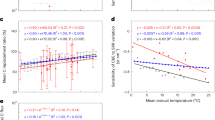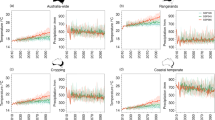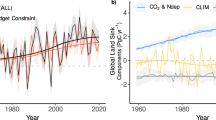Abstract
Anthropogenic land cover change (ALCC) is an important carbon (C) loss mechanism1,2,3, but current methods do not consider the role of accelerated soil organic C erosion and its burial in sediments in their assessments of net soil–atmosphere C exchange. Using a comprehensive global database and parsimonious modelling, we evaluate the impact of anthropogenic soil erosion on C fluxes between the Earth’s surface and atmosphere from the onset of agriculture to the present day. We find that agricultural erosion represents a very large and transient perturbation to the C cycle and has induced a cumulative net uptake of 78 ± 22 Pg C in terrestrial ecosystems during the period 6000 BC to AD 2015. This erosion-induced soil organic C sink is estimated to have offset 37 ± 10% of previously recognized C emissions resulting from ALCC. We estimate that rates of C burial have increased by a factor of 4.6 since AD 1850. Thus, current assessments may significantly overestimate both past and future anthropogenic emissions from the land. Given that ALCC is the most uncertain component of the global C budget and that there is a strong connection between ALCC and erosion, an explicit representation of erosion and burial processes is essential to fully understand the impact of human activities on the net soil–atmosphere C exchange.
This is a preview of subscription content, access via your institution
Access options
Access Nature and 54 other Nature Portfolio journals
Get Nature+, our best-value online-access subscription
$29.99 / 30 days
cancel any time
Subscribe to this journal
Receive 12 print issues and online access
$209.00 per year
only $17.42 per issue
Buy this article
- Purchase on Springer Link
- Instant access to full article PDF
Prices may be subject to local taxes which are calculated during checkout




Similar content being viewed by others
References
Houghton, R. A. et al. Carbon emissions from land use and land-cover change. Biogeosciences 9, 5125–5142 (2012).
Kaplan, J. O. et al. Holocene carbon emissions as a result of anthropogenic land cover change. Holocene 21, 775–791 (2011).
Pongratz, J., Reick, C. H., Raddatz, T. & Claussen, M. Effects of anthropogenic land cover change on the carbon cycle of the last millennium. Glob. Biogeochem. Cycles 23, GB4001 (2009).
Berner, R. A., Lasaga, A. C. & Garrels, R. M. The carbonate-silicate geochemical cycle and its effect on atmospheric carbon dioxide over the past 100 million years. Am. J. Sci. 283, 641–683 (1983).
Gaillardet, J., Dupré, B., Louvat, P. & Allègre, C. J. Global silicate weathering and CO2 consumption rates deduced from the chemistry of large rivers. Chem. Geol. 159, 3–30 (1999).
Burdige, D. J. Burial of terrestrial organic matter in marine sediments: a re-assessment. Glob. Biogeochem. Cycles 19, GB4011 (2005).
Galy, V. et al. Efficient organic carbon burial in the Bengal fan sustained by the Himalayan erosional system. Nature 450, 407–410 (2007).
Galy, V., Peucker-Ehrenbrink, B. & Eglinton, T. Global carbon export from the terrestrial biosphere controlled by erosion. Nature 521, 204–207 (2015).
Montgomery, D. R. Soil erosion and agricultural sustainability. Proc. Natl Acad. Sci. USA 104, 13268–13272 (2007).
Cerdan, O. et al. Rates and spatial variations of soil erosion in Europe: a study based on erosion plot data. Geomorphology 122, 167–177 (2010).
Bauska, T. K. et al. Links between atmospheric carbon dioxide, the land carbon reservoir and climate over the past millennium. Nat. Geosci. 8, 383–387 (2015).
Chappell, A., Baldock, J. & Sanderman, J. The global significance of omitting soil erosion from soil organic carbon cycling schemes. Nat. Clim. Change 6, 187–191 (2016).
Quinton, J. N., Govers, G., Van Oost, K. & Bardgett, R. D. The impact of agricultural soil erosion on biogeochemical cycling. Nat. Geosci. 3, 311–314 (2010).
Van Oost, K. et al. The impact of agricultural soil erosion on the global carbon cycle. Science 318, 626–629 (2007).
Quine, T. A. & Van Oost, K. Quantifying carbon sequestration as a result of soil erosion and deposition: retrospective assessment using caesium-137 and carbon inventories. Glob. Change Biol. 13, 2610–2625 (2007).
Lal, R. Soil erosion and the global carbon budget. Environ. Int. 29, 437–450 (2003).
Berhe, A. A., Harte, J., Harden, J. W. & Torn, M. S. The significance of the erosion-induced terrestrial carbon sink. Bioscience 57, 337–346 (2007).
Harden, J. W. et al. Dynamic replacement and loss of soil carbon on eroding cropland. Glob. Biogeochem. Cycles 13, 885–901 (1999).
Bakker, M., Govers, G., Jones, R. & Rounsevell, M. A. The effect of soil erosion on Europe’s crop yields. Ecosystems 10, 1209–1219 (2007).
Berhe, A. A., Harden, J. W., Torn, M. S. & Harte, J. Linking soil organic matter dynamics and erosion-induced terrestrial carbon sequestration at different landform positions. J. Geophys. Res. 113, G04039 (2008).
Li, Y. et al. Sustained high magnitude erosional forcing generates an organic carbon sink: test and implications in the Loess Plateau, China. Earth Planet. Sci. Lett. 411, 281–289 (2015).
Smith, S. V. et al. Soil erosion and significance for carbon fluxes in a mountainous Mediterranean-climate watershed. Ecol. Appl. 17, 1379–1387 (2007).
Van Hemelryck, H., Fiener, P., Van Oost, K., Govers, G. & Merckx, R. The effect of soil redistribution on soil organic carbon: an experimental study. Biogeosciences 7, 3971–3986 (2010).
Jacinthe, P. A., Lal, R., Owens, L. B. & Hothem, D. L. Transport of labile carbon in runoff as affected by land use and rainfall characteristics. Soil Tillage Res. 77, 111–123 (2004).
Wang, Z. et al. The fate of buried organic carbon in colluvial soils: a long-term perspective. Biogeosciences 11, 873–883 (2014).
Wang, Z., Van Oost, K. & Govers, G. Predicting the long-term fate of buried organic carbon in colluvial soils. Glob. Biogeochem. Cycles 29, 65–79 (2015).
Van Oost, K. et al. Legacy of human-induced C erosion and burial on soil–atmosphere C exchange. Proc. Natl Acad. Sci. USA 109, 19492–19497 (2012).
Hoffmann, T., Schlummer, M., Notebaert, B., Verstraeten, G. & Korup, O. Carbon burial in soil sediments from Holocene agricultural erosion, Central Europe. Glob. Biogeochem. Cycles 27, 828–835 (2013).
Omengo, F. O., Geeraert, N., Bouillon, S. & Govers, G. Deposition and fate of organic carbon in floodplains along a tropical semiarid lowland river (Tana River, Kenya). J. Geophys. Res. 121, 1131–1143 (2016).
Stallard, R. F. Terrestrial sedimentation and the carbon cycle: coupling weathering and erosion to carbon burial. Global Biogeochem. Cycles 12, 231–257 (1998).
Aufdenkampe, A. K. et al. Riverine coupling of biogeochemical cycles between land, oceans, and atmosphere. Front. Ecol. Environ. 9, 53–60 (2011).
Raymond, P. A. et al. Global carbon dioxide emissions from inland waters. Nature 503, 355–359 (2013).
Blair, N. E. & Aller, R. C. The fate of terrestrial organic carbon in the marine environment. Ann. Rev. Mar. Sci. 4, 401–423 (2012).
Tilman, D., Balzer, C., Hill, J. & Befort, B. L. Global food demand and the sustainable intensification of agriculture. Proc. Natl Acad. Sci. USA 108, 20260–20264 (2011).
Zinn, Y. L., Lal, R., Bigham, J. M. & Resck, D. V. S. Edaphic controls on soil organic carbon retention in the Brazilian Cerrado: Texture and mineralogy. Soil Sci. Soc. Am. J. 71, 1204–1214 (2007).
Jobbágy, E. G. & Jackson, R. B. The vertical distribution of soil organic carbon and its relation to climate and vegetation. Ecol. Appl. 10, 423–436 (2000).
Feller, C. & Beare, M. H. Physical control of soil organic matter dynamics in the tropics. Geoderma 79, 69–116 (1997).
2007 National Resources Inventory Summary Report (Natural Resources Conservation Service, Center for Survey Statistics and Methodology, 2009).
Klein Goldewijk, K., Beusen, A., van Drecht, G. & de Vos, M. The HYDE 3.1 spatially explicit database of human-induced global land-use change over the past 12,000 years. Glob. Ecol. Biogeogr. 20, 73–86 (2011).
Klein Goldewijk, K., Beusen, A. & Janssen, P. Long-term dynamic modeling of global population and built-up area in a spatially explicit way: HYDE 3.1. Holocene 20, 565–573 (2010).
Kaplan, J. O., Krumhardt, K. M. & Zimmermann, N. The prehistoric and preindustrial deforestation of Europe. Quat. Sci. Rev. 28, 3016–3034 (2009).
Acknowledgements
Z.W. is funded by BELSPO (IUAP programme, contract: P7-24). J.O.K. is supported by the European Research Council (313797 COEVOLVE). K.V.O. is a Senior Research Associate of the Fonds de la Recherche Scientifique (FNRS), Belgium. Support for this project was provided by the FNRS (convention number 2.4590.12). We thank S. Bouillon, H. Maclean, T. A. Quine and A. Stevens for comments on earlier versions of the manuscript.
Author information
Authors and Affiliations
Contributions
Z.W. and K.V.O. conceived the research; Z.W. performed the analysis; Z.W. and K.V.O. co-wrote the paper. All authors assisted in the interpretation of the results and commented on the manuscript.
Corresponding author
Ethics declarations
Competing interests
The authors declare no competing financial interests.
Supplementary information
Supplementary Information
Supplementary Information (PDF 4092 kb)
Rights and permissions
About this article
Cite this article
Wang, Z., Hoffmann, T., Six, J. et al. Human-induced erosion has offset one-third of carbon emissions from land cover change. Nature Clim Change 7, 345–349 (2017). https://doi.org/10.1038/nclimate3263
Received:
Accepted:
Published:
Issue Date:
DOI: https://doi.org/10.1038/nclimate3263
This article is cited by
-
Relative increases in CH4 and CO2 emissions from wetlands under global warming dependent on soil carbon substrates
Nature Geoscience (2024)
-
Temperature effect on erosion-induced disturbances to soil organic carbon cycling
Nature Climate Change (2023)
-
A Chinese soil conservation dataset preventing soil water erosion from 1992 to 2019
Scientific Data (2023)
-
Substantial role of check dams in sediment trapping and carbon sequestration on the Chinese Loess Plateau
Communications Earth & Environment (2023)
-
Decoupling of land-use net carbon flux, economic growth, and population change in China
Environmental Science and Pollution Research (2023)



